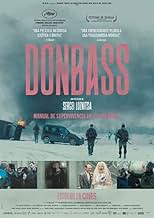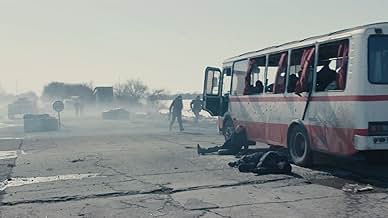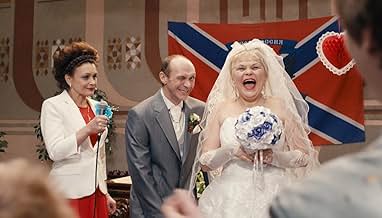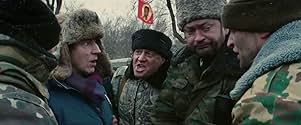VALUTAZIONE IMDb
6,6/10
5047
LA TUA VALUTAZIONE
Nell'Ucraina orientale, la società comincia a degradarsi, mentre gli effetti della propaganda e della manipolazione cominciano a emergere in questa era post-verità.Nell'Ucraina orientale, la società comincia a degradarsi, mentre gli effetti della propaganda e della manipolazione cominciano a emergere in questa era post-verità.Nell'Ucraina orientale, la società comincia a degradarsi, mentre gli effetti della propaganda e della manipolazione cominciano a emergere in questa era post-verità.
- Premi
- 9 vittorie e 14 candidature totali
Olesya Zhurakivska
- Girl with bucket
- (as Olesya Zhurakovskaya)
Trama
Lo sapevi?
- QuizOfficial submission of Ukraine for the 'Best Foreign Language Film' category of the 91st Academy Awards in 2019.
- ConnessioniReferenced in Radio Dolin: Sergei Loznitsa (2022)
- Colonne sonoreThe National Anthem of Ukraine
Lyrics by Pavlo Chubynsky
Music by Mikhailo Verbytsky
Performed by The Veryovka National Academic Ukrainian Folk Choir
Recensione in evidenza
The political events of recent weeks have brought to the attention of the whole world a geographical area whose existence most of us ignored or had very vague notions about - eastern Ukraine with the separatist regions that have proclaimed themselves recently independent republics. Those who want to know details about this conflict, which already has a violent history of eight years, can watch 'Donbass', the 2018 film by Ukrainian director Sergey Loznitsa, filmed by Oleg Mutu. I mention from the beginning the name of the cinematography director, the one who created the visual atmosphere of some of the best films of Cristian Mungiu and Cristi Puiu, because already after a few minutes of viewing I made the association with 'Memories from the Golden Age' of Mungiu . The confirmation that I had not made a mistake eventually came with the credits. But the stakes here are much higher, because unlike the Romanian director who casts an angry and sarcastic look at a recent but still past history, Sergey Loznitsa was dealing with a current tragedy in 'Donbass', and maybe, premonitory, with the future of a conflict that these days threatens to blow up the peace of Europe and the world.
Making a film about a violent conflict while this happens is no easy task. One of the most difficult obstacles is to prevent the film from becoming primarily a propaganda vehicle for one side or the other, and I will put aside the question of the historical or contemporary rightfulness of the causes of the conflicting parties. From start, Sergey Loznitsa leaves no doubt as to the side of the conflict in which he finds himself, using the official Ukrainian names of the regions in which the action takes place. There is a symmetry in the sequences that open and close the film, which have as characters a film propaganda team whose mission is to stage attacks with alleged victims on the separatists side. Death, however, is always present. The victims are real and the participants in the staging are not spared either. The constant coexistence with danger, bombings and explosions, degradation of life conditions and war damage are unknown to most people in Europe. 'Dombass' brings them to our attention and reminds us that this is a region of the continent, even if on its periphery today. In hindsight, the exposition seems prophetic, perhaps not to those who pay attention to the lessons of history, but Loznitsa's attention is directed to the people, to yesterday's neighbors now separated by history, propaganda, conflicts fueled by fake news, corruption and violence.
The filming style is a mix of pseudo-documentary with absurd comedy, and the boundaries are not always clear. As in a news diary or as in life, there is no clear line of action, some characters return, but each of the ten or so episodes could be a stand-alone report or short film. Some of them are pseudo-documentaries, inspired by real events and situations but filmed in the style of news sequences, with hand-held camera, long takes, live sound caption. A few other episodes are working, at least roughly, according to some script, but it is clear that the actors have been allowed to improvise and live their roles. The vision of the degradation of human relations in times of conflict is pessimistic and desolate. The absurd seems to dominate scenes such as the wedding or the one in which a businessman who came to recover his stolen car is blackmailed to donate it 'for the anti-fascist fight', to find out that he is just one of many in the same situation. The inspiration of Kusturica's and Mungiu's films is obvious. Other scenes have a more tragic tone - that of the bus with refugees returning to the separatist areas or that of the Ukrainian prisoner in danger of being lynched by the crowd intoxicated by propaganda. In both kinds of sequences, the distance between what we see on the screen and reality fades. The cold, the fog, the fear, the violence, the absurdity experienced by the people on screen envelop us. Now, four years after filming, it's the end of winter in Ukraine again. What we saw in 'Dombass' we see in the news and seems to become a reality that envelops us all.
Making a film about a violent conflict while this happens is no easy task. One of the most difficult obstacles is to prevent the film from becoming primarily a propaganda vehicle for one side or the other, and I will put aside the question of the historical or contemporary rightfulness of the causes of the conflicting parties. From start, Sergey Loznitsa leaves no doubt as to the side of the conflict in which he finds himself, using the official Ukrainian names of the regions in which the action takes place. There is a symmetry in the sequences that open and close the film, which have as characters a film propaganda team whose mission is to stage attacks with alleged victims on the separatists side. Death, however, is always present. The victims are real and the participants in the staging are not spared either. The constant coexistence with danger, bombings and explosions, degradation of life conditions and war damage are unknown to most people in Europe. 'Dombass' brings them to our attention and reminds us that this is a region of the continent, even if on its periphery today. In hindsight, the exposition seems prophetic, perhaps not to those who pay attention to the lessons of history, but Loznitsa's attention is directed to the people, to yesterday's neighbors now separated by history, propaganda, conflicts fueled by fake news, corruption and violence.
The filming style is a mix of pseudo-documentary with absurd comedy, and the boundaries are not always clear. As in a news diary or as in life, there is no clear line of action, some characters return, but each of the ten or so episodes could be a stand-alone report or short film. Some of them are pseudo-documentaries, inspired by real events and situations but filmed in the style of news sequences, with hand-held camera, long takes, live sound caption. A few other episodes are working, at least roughly, according to some script, but it is clear that the actors have been allowed to improvise and live their roles. The vision of the degradation of human relations in times of conflict is pessimistic and desolate. The absurd seems to dominate scenes such as the wedding or the one in which a businessman who came to recover his stolen car is blackmailed to donate it 'for the anti-fascist fight', to find out that he is just one of many in the same situation. The inspiration of Kusturica's and Mungiu's films is obvious. Other scenes have a more tragic tone - that of the bus with refugees returning to the separatist areas or that of the Ukrainian prisoner in danger of being lynched by the crowd intoxicated by propaganda. In both kinds of sequences, the distance between what we see on the screen and reality fades. The cold, the fog, the fear, the violence, the absurdity experienced by the people on screen envelop us. Now, four years after filming, it's the end of winter in Ukraine again. What we saw in 'Dombass' we see in the news and seems to become a reality that envelops us all.
I più visti
Accedi per valutare e creare un elenco di titoli salvati per ottenere consigli personalizzati
- How long is Donbass?Powered by Alexa
Dettagli
- Data di uscita
- Paesi di origine
- Sito ufficiale
- Lingue
- Celebre anche come
- Донбас
- Luoghi delle riprese
- Aziende produttrici
- Vedi altri crediti dell’azienda su IMDbPro
Botteghino
- Lordo in tutto il mondo
- 141.067 USD
- Tempo di esecuzione2 ore 2 minuti
- Colore
- Proporzioni
- 2.35 : 1
Contribuisci a questa pagina
Suggerisci una modifica o aggiungi i contenuti mancanti


![Guarda Trailer [OV]](https://m.media-amazon.com/images/M/MV5BZDBjMTdhZDYtOWI4NS00NmYwLWExYjgtY2VmYzQxYzlkNDhmXkEyXkFqcGdeQXRyYW5zY29kZS13b3JrZmxvdw@@._V1_QL75_UX500_CR0)
























